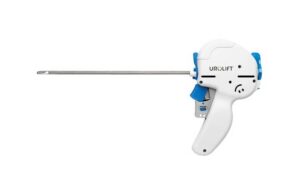
Teleflex (NYSE:TFX) today announced new research from multiple studies supporting the prostatic urethral lift (PUL) procedure with its UroLift system.
Wayne, Pennsylvania-based Teleflex designed UroLift to treat men with benign prostatic hyperplasia (BPH). It presented data at the 38th Annual European Association of Urology (EAU) Congress in Milan, Italy.
The company said in a news release that its study results demonstrate the benefits of early intervention. This comes through durability, symptom improvement and sexual function associated with the UroLift system, Teleflex said.
“These important new analyses show that, whether compared to other interventions or medication, the UroLift System offers unique benefits that make it the treatment of choice for many men searching for long-term relief of burdensome BPH symptoms,” said Jacqueline Welch, VP, global clinical and scientific operations, Teleflex.
PUL with the Teleflex UroLift system
Teleflex reported results from more than 330 PUL subjects studied in a controlled setting. PUL with UroLift proved durable in most subjects at one and five years. Teleflex said lower durability at one year is associated with undertreatment. It found that poor baseline obstructive symptoms affected lower durability at five years.
Additionally, Teleflex observed positive impacts on quality of life through earlier treatment in the disease continuum. The company said treatment with UroLift prior to severe erectile dysfunction in sexually active patients predicts the likelihood of a patient achieving meaningful change in the Sexual Health Inventory for Men assessment.
Obstructive median lobe (OML) subjects
In responder analysis using novel BPH6 study endpoints, UroLift OML and lateral lobe patients responded consistently. BPH6 endpoints include relief of symptoms, quality of recovery, preservation of sexual function, preservation of continence and safety.
Compared to transurethral resection of the prostate (TURP) done in lateral lobes, UroLift subjects achieved superior quality of recovery and preservation of ejaculatory function, Teleflex said. Additionally, only TURP subjects experienced high-severity adverse events.
The largest healthcare utilization study for BPH therapies
Teleflex said its study for BPH therapies (including medication) found approximately 6% of medical therapy patients underwent BPH-related procedures through one year as the disease progressed.
The company observed similar complication rates between TURP, photoselective vaporization of the prostate and Aquablation. It found the lowest complication rates associated with PUL with the UroLift system. Teleflex noted that Aquablation data were relatively immature due to the newness of the technology. Its complication rate (around 20%) indicates a safety profile similar to more invasive treatments.
“The research presented at EAU reinforces the UroLift System as an effective and durable BPH solution, backed by meaningful quality of life data that support a superior patient experience,” said Dr. Steven Gange of Summit Urology Group and associate medical director of Teleflex’s interventional urology business unit. “The results from these studies emphasize the value of the UroLift System in successfully treating BPH symptoms, enabling rapid recovery, preserving sexual function, and improving patients’ overall quality of life.”